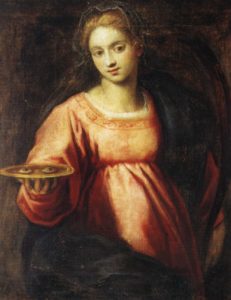 13 December was the darkest day – with the least sunlight – of the old Julian calendar.
13 December was the darkest day – with the least sunlight – of the old Julian calendar.
Today in the Gregorian calendar is the feast of St. Lucy, whose name from the Latin lux, for “light”, reminds us who dwell in the still darkening northern hemisphere that our days will soon be getting longer again.
Lucy will usually be depicted in art with a lantern, or with a crown of candles, or – most commonly – with her own eyes on a platter.
Some accounts have Lucy slain by having her throat thrust through with sword. Other accounts say that to protect her virginity she disfigured herself by cutting her own eyes out and sending them to her suitor, a plot likely to discourage him. St. Lucy is therefore the patroness of sight.
St. Lucy shows up fairly often in Dante’s great Divine Comedy. She is first in the Inferno. It is Lucy who asked Beatrice to help Dante. In Purgatory the eagle that bears Dante upward in a dream is actually Lucy who is bearing him to the gate of Purgatory. Eagles, of course, are “eagle-eyed” and see very well. In the Paradiso she is placed directly across from Adam in the Heaven of the Rose. She can gaze directly at God. St. Lucy was something of a patroness for Dante and that he was devoted to her because, as we glean from various works, he may have had a problem not just with his eyes but also struggling with sins of the eyes.
Next week we also have Ember Days, which in Advent come after the Feast of St. Lucy. Do you remember the little mnemonic poem? “Lenty, Penty, Crucy, Lucy”, or else “Fasting days and Emberings be / Lent, Whitsun, Holyrood, and Lucie.”
Ember Wednesday will be the Missa aurea.
In the meantime, let’s have a look at Lucy’s Collect in the Ordinary Form.
This prayer was not in the pre-Conciliar editions of the Missale Romanum. It is based on a prayer in the ancient Gelasian Sacramentary for St. Felicity (VIIII KALENDAS DECEMBRIS).
Intercessio nos, quaesumus, Domine, sanctae Luciae virginis et martyris gloriosa confoveat, ut eius natalicia et temporaliter frequentemus, et conspiciamus aeterna.
First, you will have immediately caught the elegant hyperbaton, the separation of intercessio and the adjective that goes with it, gloriosa. There is also a nice et… et construction.
Confoveo is “to cherish, caress, keep warm.” It is a compound of foveo which essentially is “to be hot, to roast”. It obviously deals with heat, flame, light. This is a good word for this time of year in the northern hemisphere (unless you are in, say, Florida).
Conspicio is “to look at attentively, to get sight of, to descry, perceive, observe”. We are obviously dealing the seeing and sight. This word should ring mental bells for the throngs of you readers who attended Holy Mass in the Novus Ordo celebrated in Latin. Conspicio is in the Collect for the 3rd Sunday of Advent, used in a an extremely clever way juxtaposed to exspecto. They share a common root. But I digress.
Natalicia refers to birthdays. In the Christian adaptation of this word, we are always referring to the saints being “born” into heaven.
OBSOLETE ICEL (1973):
Lord, give us courage through the gracious prayers of Saint Lucy. As we celebrate her entrance into eternal glory, we ask to share her happiness in the life to come.
Here is the usual clunky parataxis we know so well from the dreadful obsolete translation. As usual, the translation is dumbed-down. Do you see anything of the concept of vision? Sight? Is there anything in there that harks to the time of year?
Can you believe that some people want this back?
CURRENT ICEL (2011):
May the glorious intercession of the Virgin and Martyr Saint Lucy give us new heart, we pray, O Lord, so that we may celebrate her heavenly birthday in this present age and so behold things eternal.
We are obviously much closer to the Latin in this new version. Also, that behold at the end is consoling.
Reason #7569320 for the new, corrected translation.
Perhaps you might say a prayer today to St. Lucy, that she will intercede with God and implore Him, for us in the vale of tears, to open the eyes of so many of our elected officials – and voters – and our Church leaders too, while we’re at it.






You must be logged in to post a comment.